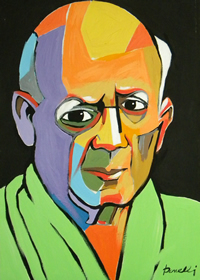
The “early cross collection” was followed by additional crosses in succeeding years. The collections are arranged by years in which they were produced. (click on any cross to enlarge and display slide show)
Beginning with 2018, crosses and other items are located on the Art Displays pages of this website, arranged by the year of the display.
Pablo Picasso
1881-1973

Malibu Rum, Arts 11/13
www.artistli.com/pablo-picasso/
In September–October of 1932 Pablo Picasso composed numerous studies of the crucifixion using pen & ink. These small sketches found in one of his sketch books (each approx. 14” x 20”) were based on Matthias Grűnewald’s large polytriptych, the Isenheim Altarpiece. Picasso’s drawings straddle the border between Expressionism and Surrealism with stylistic abstract references to bodily forms–bones, rib cages, skulls–all over-lapping, dark and brooding. A number of them have a black ground which highlights the whiteness of the forms, copying the effect which Grűnewald achieved with his dark, compressed space.
Picasso never translated any of these studies into a painting, preferring to continue the style with paintings of beach scenes, bathers, bull fights, horses and the minotaur. By 1937 he was adapting these forms to etchings–political cartoons mocking and opposing the dictator, Francisco Franco. They also were useful in his approximately 50 studies prior to the painting of Guernica in 1937, his famous mural protesting the bombing of a defenseless Basque town by the Nazis during the Spanish Civil War, which was displayed at the Spanish pavilion at the International Exposition in Paris. This painting showed the horror of a modern day crucifixion.
As a liturgical artist I’m captivated by the combination of Grűnewald and Picasso. The Isenheim Altar’s central panel of the crucifixion is an ikon that pictures what Martin Luther called the “theology of the cross.” Picasso captures the surreal context of crucifixion and its twisted torture of the body of Christ. The pathos is depicted with forms resembling bones scattered helter-skelter over the landscape and around the cross. Darkness covers the earth. In my pectoral cross designs for the “Picasso Suite” I adopt and adapt some of Picasso’s forms to convey pathos.